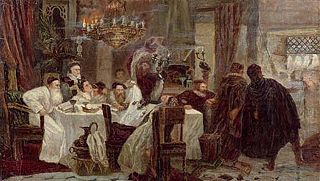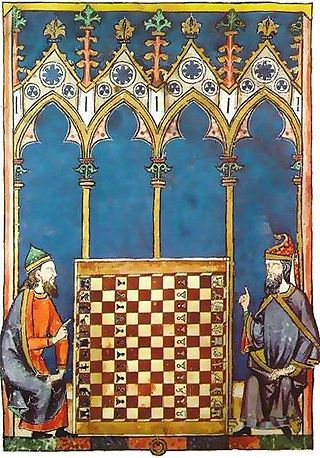Related Research Articles

The Romaniote Jews or the Romaniotes are a Greek-speaking ethnic Jewish community native to the Eastern Mediterranean. They are one of the oldest Jewish communities in existence and the oldest Jewish community in Europe. The Romaniotes have been, and remain, historically distinct from the Sephardim, some of whom settled in Ottoman Greece after the expulsion of Jews from Spain and Portugal after 1492.

SephardicJews, also known as Sephardi Jews or Sephardim, and rarely as Iberian Peninsular Jews, are a Jewish diaspora population associated with the Iberian Peninsula. The term, which is derived from the Hebrew Sepharad, can also refer to the Jews of the Middle East and North Africa, who were also heavily influenced by Sephardic law and customs. Many Iberian Jewish exiled families also later sought refuge in those Jewish communities, resulting in ethnic and cultural integration with those communities over the span of many centuries.

Marranos is one of the terms used in relation to Spanish and Portuguese Jews who converted or were forced by the Spanish and Portuguese crowns to convert to Christianity during the fifteenth and sixteenth centuries, but continued to practice Judaism in secrecy or were suspected of it, referred to as Crypto-Jews. "Crypto-Jew" is the term increasingly preferred in scholarly works, instead of Marrano.

Sephardic law and customs are the law and customs of Judaism which are practiced by Sephardim or Sephardic Jews ; the descendants of the historic Jewish community of the Iberian Peninsula, what is now Spain and Portugal. Many definitions of "Sephardic" also include Mizrahi Jews, most of whom follow the same traditions of worship as those which are followed by Sephardic Jews. The Sephardi Rite is not a denomination nor is it a movement like Orthodox Judaism, Reform Judaism, and other Ashkenazi Rite worship traditions. Thus, Sephardim comprise a community with distinct cultural, juridical and philosophical traditions.
Mizrahi Jews, also known as Mizrahim (מִזְרָחִים) or Mizrachi (מִזְרָחִי) and alternatively referred to as Oriental Jews or Edot HaMizrach, are a grouping of Jewish communities comprising those who existed in the Muslim world.

The Alhambra Decree was an edict issued on 31 March 1492, by the joint Catholic Monarchs of Spain ordering the expulsion of practising Jews from the Crowns of Castile and Aragon and its territories and possessions by 31 July of that year. The primary purpose was to eliminate the influence of practising Jews on Spain's large formerly-Jewish converso New Christian population, to ensure the latter and their descendants did not revert to Judaism. Over half of Spain's Jews had converted as a result of the religious persecution and pogroms which occurred in 1391. Due to continuing attacks, around 50,000 more had converted by 1415. A further number of those remaining chose to convert to avoid expulsion. As a result of the Alhambra decree and persecution in the years leading up to the expulsion of Spain's estimated 300,000 Jewish origin population, a total of over 200,000 had converted to Catholicism to remain in Spain, and between 40,000 and 100,000 remained Jewish and suffered expulsion. An unknown number of the expelled eventually succumbed to the pressures of life in exile away from formerly-Jewish relatives and networks back in Spain, and so converted to Catholicism to be allowed to return in the years following expulsion.:17
Spanish and Portuguese Jews, also called Western Sephardim, Iberian Jews, or Peninsular Jews, are a distinctive sub-group of Sephardic Jews who are largely descended from Jews who lived as New Christians in the Iberian Peninsula during the few centuries following the forced expulsion of unconverted Jews from Spain in 1492 and from Portugal in 1497. They should therefore be distinguished both from the descendants of those expelled in 1492 and from the present-day Jewish communities of Spain and Portugal.

The history of the Jews in the current-day Spanish territory stretches back to Biblical times according to Jewish tradition, but the settlement of organised Jewish communities in the Iberian Peninsula possibly traces back to the times after the destruction of the Second Temple in 70 CE. The earliest archaeological evidence of Hebrew presence in Iberia consists of a 2nd-century gravestone found in Mérida. From the late 6th century onward, following the Visigothic monarchs' conversion from Arianism to the Nicene Creed, conditions for Jews in Iberia considerably worsened.

The Spanish Benveniste family is an old, noble, wealthy, and scholarly Jewish family of Narbonne, France and northern Spain established in the 11th century. The family was present in the 11th to the 15th centuries in Hachmei Provence, France, Barcelona, Aragon and Castile.
Italian Jews or Roman Jews can be used in a broad sense to mean all Jews living in or with roots in Italy, or, in a narrower sense, to mean the Italkim, an ancient community living in Italy since the Ancient Roman era, who use the Italian liturgy as distinct from those Jewish communities in Italy dating from medieval or modern times who use the Sephardic liturgy or the Nusach Ashkenaz.
The halukka, also spelled haluka, halukkah or chalukah was an organized collection and distribution of charity funds for Jewish residents of the Land of Israel.

Ben-Zion Meir Hai Uziel, sometimes rendered as Ouziel, was the Sephardi chief rabbi of Mandatory Palestine from 1939 to 1948, and of Israel from 1948 until his death in 1953.

Yaakov Meir CBE (1856–1939), was an Orthodox rabbi, and the first Sephardic Chief Rabbi appointed under the British Mandate of Palestine. A Talmudic scholar, fluent in Hebrew as well as five other languages, he enjoyed a reputation as one of Jerusalem's most respected rabbis.
Meshuchrarim are a Jewish community of freed slaves, often of mixed-race African-European descent, who accompanied Sephardic Jews in their immigration to India following the 16th-century expulsion from Spain. The Sephardic Jews became known as the Paradesi Jews.

By the time the Ottoman Empire rose to power in the 14th and 15th centuries, there had been Jewish communities established throughout the region. The Ottoman Empire lasted from the early 12th century until the end of World War I and covered parts of Southeastern Europe, Anatolia, and much of the Middle East. The experience of Jews in the Ottoman Empire is particularly significant because the region "provided a principal place of refuge for Jews driven out of Western Europe by massacres and persecution."

On 5 December 1496, King Manuel I of Portugal signed the decree of expulsion of Jews and Muslims to take effect by the end of October of the next year.
North African Sephardim are a distinct sub-group of Sephardi Jews, who descend from exiled Iberian Jewish families of the late 15th century and North African Maghrebi Jewish communities.
Eastern Sephardim are a distinctive sub-group of Sephardic Jews mostly descended from Jewish families which were exiled from Iberia in the 15th century, following the Alhambra Decree of 1492 in Spain and a similar decree in Portugal five years later. This branch of descendants of Iberian Jews settled across the Eastern Mediterranean.
Megorashim is a term used to refer to Jews from the Iberian Peninsula who arrived in North Africa as a result of the anti-Jewish persecutions of 1391 and the expulsion of Jews from Spain in 1492. These migrants were distinct from pre-existing North African Jews called Toshavim. The Toshavim had been present in North Africa since ancient times, spoke the local languages, and had traditions that were influenced by Maghrebi Islam. The Megorashim influenced North African Judaism, incorporating traditions from Spain. They eventually merged with the Toshavim, so that it is now difficult to distinguish between the two groups. The Jews of North Africa are often referred to as Sephardi, a term that emphasizes their Iberian traditions.

Istanbul became one of the world's most important Jewish centers in the 16th and 17th centuries. In marked contrast to Jews in Europe, Ottoman Jews were allowed to work in any profession and could also enter the Ottoman court. Ottoman Jews in Istanbul excelled in commerce and trade and came to dominate the medical profession. Despite making up only 10% of the city population, Jews constituted 62% of licensed doctors in 1600.
References
![]() This article incorporates text from a publication now in the public domain : Kayserling, Meyer (1901). "Amigo, Meir". In Singer, Isidore; et al. (eds.). The Jewish Encyclopedia . Vol. 1. New York: Funk & Wagnalls. p. 520.
This article incorporates text from a publication now in the public domain : Kayserling, Meyer (1901). "Amigo, Meir". In Singer, Isidore; et al. (eds.). The Jewish Encyclopedia . Vol. 1. New York: Funk & Wagnalls. p. 520.
- ↑ Franco, M. (1897). Essai sur l'histoire des Israélites de l'Empire ottoman depuis les origines jusqu'à nos jours (in French). Paris: Librairie A. Durlacher. p. 121.
- 1 2 "Amigo, Meir". The Museum of the Jewish People at Beit Hatfutsot . Retrieved 16 March 2019.
- ↑ Marton, Yehouda (2007). "Amigo". In Berenbaum, Michael; Skolnik, Fred (eds.). Encyclopaedia Judaica . Vol. 2 (2nd ed.). Detroit: Macmillan Reference. p. 77. ISBN 978-0-02-866097-4.